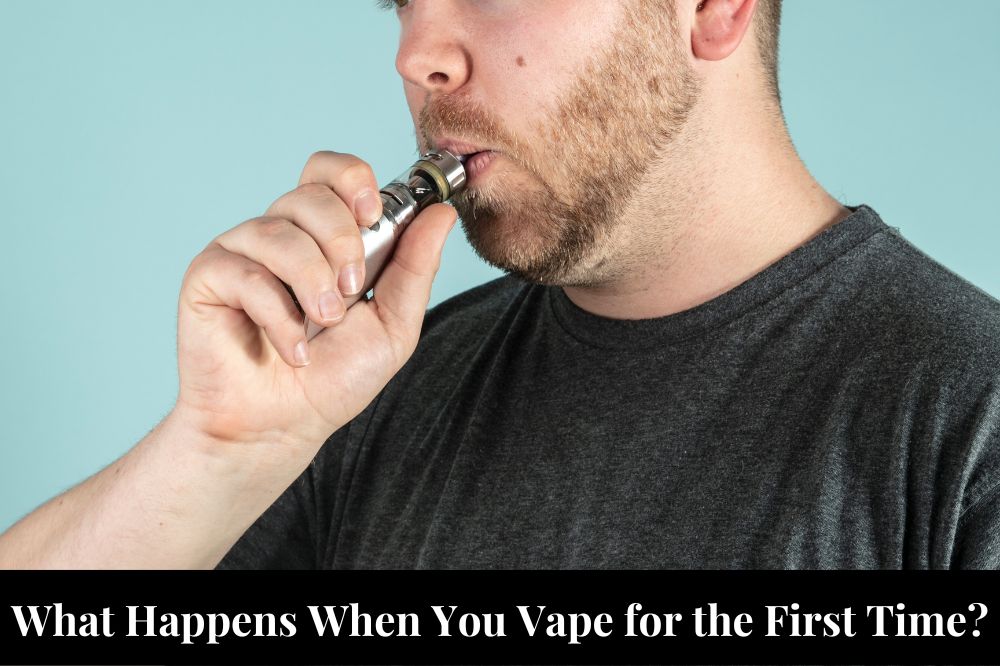
Vaping has become a popular alternative to smoking in recent years, with millions of people worldwide making the switch. If you are considering trying vaping for the first time, it’s important to understand what to expect. In this article, I will explore what happens when you vape for the first time, including the potential effects on your body and mind.
When you take your first puff on a vape, you may experience a sensation in your throat, similar to the feeling of inhaling smoke from a cigarette. This sensation is caused by the vapor passing over the delicate tissues in your throat and can be quite different from the harshness of smoking. You may also notice a taste in your mouth, depending on the flavor of the e-liquid you are using.
As you continue to vape, you may begin to feel a sense of relaxation, which can be a welcome change from the jitters and anxiety that can come with smoking. However, it’s important to note that vaping can also cause dizziness or lightheadedness, especially if you inhale too much too quickly. In the next section, we will explore some tips for first-time vapers to help you get the most out of your experience.
Understanding Vaping
Definition of Vaping
Vaping is the act of inhaling and exhaling vapor produced by an electronic cigarette or other vaping devices. This vapor is created by heating a liquid known as e-liquid or vape juice, which usually contains nicotine, flavorings, and other chemicals. Vaping is often used as an alternative to smoking traditional cigarettes, as it is believed to be less harmful to the body.
Components of a Vape
A vape consists of several components that work together to create vapor. These components include:
- Battery: The battery is the power source for the vape and is usually rechargeable. It provides the energy needed to heat the coil and vaporize the e-liquid.
- Coil: The coil is a small heating element that is wrapped in a wick. When the battery is activated, it heats the coil, which then vaporizes the e-liquid.
- Tank: The tank holds the e-liquid and is connected to the coil. When the battery is activated, the coil heats up, which causes the e-liquid to vaporize and be drawn up through the wick and into the mouthpiece.
- Mouthpiece: The mouthpiece is where the vapor is inhaled. It is usually made of plastic or metal and is attached to the tank.
In addition to these components, some vapes also have additional features such as adjustable airflow, temperature control, and variable wattage. These features allow users to customize their vaping experience to their liking.
Overall, understanding the basics of vaping can help first-time vapers feel more comfortable and confident when trying it for the first time. By knowing what to expect and how the device works, users can make informed decisions about their vaping experience.
SPIRITBAR Katana BP10000
- Slender, leather-textured body reminiscent of a katana handle for an authentic samurai feel
- Unique samurai-inspired e-liquid flavor - fruity yet not too sweet, with a luxurious, elegant aroma
- Powerful 650mAh rechargeable battery for extended vaping time
- Large 18ml e-liquid capacity and 10,000 puff capacity
- Advanced mesh coil and e-liquid & power display screens for optimal vaping experience
The special juice captures the essence of the samurai spirit with its rich, smoothly pulsating flavor that brings new satisfaction with every puff. The device's slender, leather-textured design evokes the grip of a samurai's katana, making this product a perfect choice for beginner vapors.
The Immediate Effects of Vaping
When you vape for the first time, you will experience some immediate effects. These effects can be physical sensations and psychological responses.
Physical Sensations
One of the most noticeable physical sensations that you will feel when you vape for the first time is the throat hit. This is a small tingling or burning sensation that you will feel in your throat when you inhale the vapor. This sensation is caused by the vapor making contact with your throat. It is important to note that this sensation is different from smoking a cigarette.
Another physical sensation that you may feel when you vape for the first time is a dry mouth. This is because the vapor can dehydrate your mouth, causing it to feel dry. Drinking water can help alleviate this sensation.
You may also experience dizziness or lightheadedness when you vape for the first time. This is because the nicotine in the vapor can cause a drop in blood pressure. If you experience these symptoms, it is important to sit down and take a break.
SPIRITBAR Jack’s Flask 9000 Puffs
- Stylish pirate flask-shaped body providing an exciting vaping experience
- Delivering up to 9000 puffs per device
- 20ml e-liquid capacity with 50mg nicotine strength for satisfying throat hit
- Specialized pirate-themed e-juice flavors for rich, swirling taste
- Premium mesh coil optimizes flavor profile for maximum vaping enjoyment
This disposable vape captures the daring spirit of the high seas with its flask styling and signature pirate e-juice flavors. The extraordinary battery life provides 9000 indulgent puffs for extended vaping pleasure. Live boldly and freely with the Jack's Flask - a legendary vaping experience fit for a pirate's adventures.
Psychological Responses
When you vape for the first time, you may experience some psychological responses. One of these responses is a feeling of relaxation. This is because the nicotine in the vapor can have a calming effect on the body.
You may also experience a sense of euphoria or pleasure when you vape for the first time. This is because the nicotine in the vapor can stimulate the release of dopamine in the brain, which is a neurotransmitter that is associated with pleasure.
It is important to note that these psychological responses can be addictive and can lead to a dependence on vaping. Therefore, it is important to be aware of the potential risks of vaping and to use it responsibly.
Potential Risks and Side Effects
When trying vaping for the first time, it is important to be aware of the potential risks and side effects associated with this activity. While vaping is often marketed as a safer alternative to smoking traditional cigarettes, it is not without its own set of risks.
Short Term Effects
The short-term effects of vaping can vary depending on the individual, the device used, and the substance being vaped. Some common short-term effects of vaping include:
- Dry mouth and throat: Vaping can cause dryness in the mouth and throat, which can be uncomfortable and lead to coughing or irritation.
- Dizziness and nausea: Some people may experience dizziness or nausea after vaping, particularly if they are new to the activity or have used a device with a high nicotine content.
- Headaches: Vaping can sometimes cause headaches, particularly if the device is used excessively or if the user is sensitive to the substances being vaped.
- Increased heart rate: Vaping can cause an increase in heart rate, which can be dangerous for people with heart conditions or other underlying health issues.
- Allergic reactions: Some people may be allergic to certain substances used in vaping devices, which can cause a range of symptoms including itching, swelling, and difficulty breathing.
Long Term Effects
While the long-term effects of vaping are not yet fully understood, there is growing evidence that vaping can have negative health consequences. Some potential long-term effects of vaping include:
- Lung damage: Vaping has been linked to lung damage and respiratory issues, particularly when used over a long period of time.
- Cardiovascular issues: Vaping can also increase the risk of cardiovascular issues such as heart disease and stroke.
- Nicotine addiction: Many vaping devices contain nicotine, which is highly addictive and can lead to long-term addiction and dependence.
- Toxic chemical exposure: Vaping devices can expose users to a range of toxic chemicals, including formaldehyde and acetaldehyde, which can have negative health effects over time.
It is important to be aware of these potential risks and side effects before trying vaping for the first time. If you experience any negative symptoms after vaping, it is important to seek medical attention and discontinue use of the device.
Comparing Vaping to Traditional Smoking
When it comes to smoking, there are two main options: traditional cigarettes and vaping. While both involve inhaling some form of smoke or vapor, there are significant differences between the two.
Firstly, traditional cigarettes contain tobacco, which is a known carcinogen and can lead to a variety of health problems. Vaping, on the other hand, typically involves using an e-cigarette or similar device to heat up a liquid containing nicotine, flavorings, and other chemicals. While the long-term effects of vaping are still being studied, it is generally considered to be less harmful than smoking.
Another key difference between traditional smoking and vaping is the way in which the smoke or vapor is produced. With cigarettes, tobacco is burned, which creates smoke that is then inhaled. Vaping, on the other hand, involves heating up a liquid to create a vapor that is then inhaled. This means that vaping produces less smoke and odor than traditional smoking.
SPIRITBAR Katana BP10000
- Slender, leather-textured body reminiscent of a katana handle for an authentic samurai feel
- Unique samurai-inspired e-liquid flavor - fruity yet not too sweet, with a luxurious, elegant aroma
- Powerful 650mAh rechargeable battery for extended vaping time
- Large 18ml e-liquid capacity and 10,000 puff capacity
- Advanced mesh coil and e-liquid & power display screens for optimal vaping experience
The special juice captures the essence of the samurai spirit with its rich, smoothly pulsating flavor that brings new satisfaction with every puff. The device's slender, leather-textured design evokes the grip of a samurai's katana, making this product a perfect choice for beginner vapors.
In terms of nicotine content, cigarettes typically contain more nicotine than e-cigarettes. However, e-cigarettes can be customized to contain varying levels of nicotine depending on the user’s preferences. Additionally, vaping allows for a wider range of flavors and options than traditional smoking.
Overall, while both traditional smoking and vaping involve inhaling some form of smoke or vapor, there are significant differences between the two. Vaping is generally considered to be less harmful than smoking, and allows for greater customization and variety in terms of nicotine content and flavor options.
The Role of Nicotine in Vaping
As someone who is new to vaping, it is important to understand the role of nicotine in vaping. Nicotine is a highly addictive substance that is found in most vaping products. It is the main reason why people continue to use e-cigarettes and other vaping devices. In this section, I will explain the effects of nicotine on the body and what happens when you stop using it.
Nicotine Addiction
Nicotine is a stimulant that activates the brain’s reward system. When you inhale nicotine, it enters your bloodstream and quickly reaches your brain. Once there, it releases a surge of dopamine, a neurotransmitter that is responsible for feelings of pleasure and reward. This surge of dopamine creates a temporary feeling of euphoria and relaxation.
Over time, your brain becomes dependent on nicotine to release dopamine. This is what causes addiction. The more you use nicotine, the more your brain craves it. This is why it can be difficult to quit vaping or smoking once you start.
Nicotine Withdrawal
When you stop using nicotine, your brain goes through a period of adjustment. This is known as withdrawal. Withdrawal symptoms can include anxiety, irritability, difficulty concentrating, and intense cravings for nicotine. These symptoms can be very uncomfortable and can make it difficult to quit vaping or smoking.
It is important to note that nicotine withdrawal is temporary. Most symptoms will peak within the first few days of quitting and will gradually subside over the following weeks. It is important to have a plan in place to help manage withdrawal symptoms. This can include using nicotine replacement therapy, such as nicotine gum or patches, or seeking support from a healthcare professional or support group.
In conclusion, nicotine is a highly addictive substance that is found in most vaping products. It is the main reason why people continue to use e-cigarettes and other vaping devices. Understanding the effects of nicotine on the body and what happens when you stop using it is an important step in quitting vaping or smoking.
Vaping and Public Perception
Vaping has become increasingly popular in recent years, with many people choosing it as an alternative to smoking. However, despite its growing popularity, vaping still faces a lot of public scrutiny and negative perception.
One of the main reasons for this negative perception is the lack of long-term studies on the effects of vaping on health. While it is widely accepted that vaping is less harmful than smoking, many people still view it as a potentially dangerous habit.
Another reason for the negative perception of vaping is the association with e-cigarettes and the tobacco industry. Many people view vaping as just another way for big tobacco companies to profit off of addiction.
Additionally, the media often portrays vaping in a negative light, highlighting stories of exploding batteries and other safety concerns. While these incidents are rare, they contribute to the overall negative perception of vaping.
Despite these challenges, there are many advocates for vaping who believe that it can be a useful tool for harm reduction. Studies have shown that vaping can be an effective way to quit smoking, and many people have successfully used vaping as a stepping stone to quitting nicotine altogether.
Overall, while vaping still faces a lot of public scrutiny and negative perception, it is important to remember that it can be a useful tool for harm reduction. As more research is conducted on the long-term effects of vaping, it is likely that the public perception of vaping will continue to evolve.
Regulations and Legal Aspects of Vaping
As with any activity, vaping is subject to regulations and legal restrictions. It is important to be aware of these rules to avoid potential legal issues. Here are some of the most important regulations and legal aspects of vaping:
- Age restrictions: Federal law requires that consumers must be 21 or older to buy tobacco products, including vaping products. This law took effect on December 20, 2019, and it is now illegal for retailers to sell any tobacco product, including e-cigarettes, to anyone under the age of 21. Some states have even stricter age requirements, so it’s important to check local regulations.
- Bans on vaping in public places: Many states and cities have banned vaping in public places, including restaurants, bars, and other indoor areas. These bans are often put in place to protect non-smokers from secondhand exposure to e-cigarette aerosol.
- Restrictions on advertising: The FDA has strict rules about how e-cigarettes can be advertised. For example, companies are not allowed to make any health claims about their products unless they have been approved by the FDA.
- Shipping restrictions: On March 27, 2021, Congress amended the Preventing All Cigarette Trafficking (PACT) Act to include new regulations regarding the delivery and sales of electronic nicotine delivery systems (ENDS), which include e-cigarettes, “vapes,” flavored and smokeless tobacco. These regulations include age verification requirements for online sales and shipping restrictions.
It is important to stay up-to-date with regulations and legal restrictions on vaping, as they can change frequently. By following these rules and being aware of the legal aspects of vaping, you can enjoy the activity without running into legal issues.
Frequently Asked Questions
Can vaping for the first time cause chest pain?
It is possible to experience chest pain when vaping for the first time. This could be due to the irritation of the lungs caused by inhaling the vapor. However, chest pain can also be a sign of a more serious condition, such as a heart attack. If you experience chest pain when vaping, it is important to seek medical attention immediately.
What are the risks of vaping for the first time?
Vaping for the first time can expose you to a number of risks. These risks include nicotine addiction, lung irritation, and exposure to harmful chemicals. It is important to understand the potential risks associated with vaping and to make an informed decision about whether or not to start vaping.
How does vaping for the first time affect your body?
Vaping for the first time can affect your body in a number of ways. The nicotine in e-cigarettes can cause an increase in heart rate and blood pressure, as well as a release of adrenaline. This can lead to feelings of dizziness, lightheadedness, and nausea. Vaping can also irritate the lungs and cause coughing and wheezing.
What should you expect when vaping for the first time?
When vaping for the first time, you should expect to feel a sensation in your throat, a taste in your mouth, and a feeling of relaxation. You may also experience dizziness or lightheadedness, and coughing. It is important to start with a low nicotine level, take small puffs, and stay hydrated.
What are some tips for vaping for the first time?
Some tips for vaping for the first time include starting with a low nicotine level, taking small puffs, choosing a flavor you like, staying hydrated, and avoiding exposure to harmful chemicals. It is also important to understand the potential risks associated with vaping and to make an informed decision about whether or not to start vaping.
Is it safe to vape for the first time if you’re a non-smoker?
No, it is not safe to vape for the first time if you’re a non-smoker. Vaping can expose you to harmful chemicals and increase your risk of nicotine addiction. It is important to make an informed decision about whether or not to start vaping, and to understand the potential risks associated with vaping.








